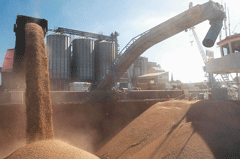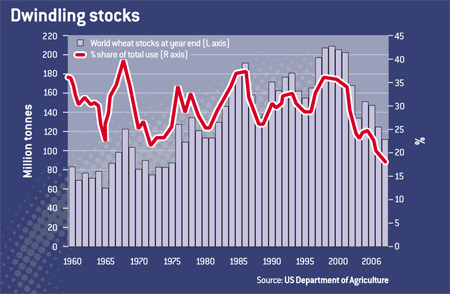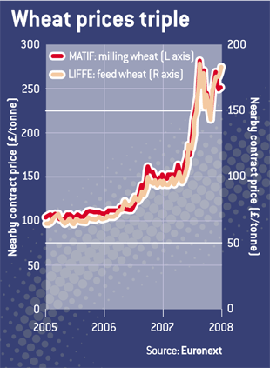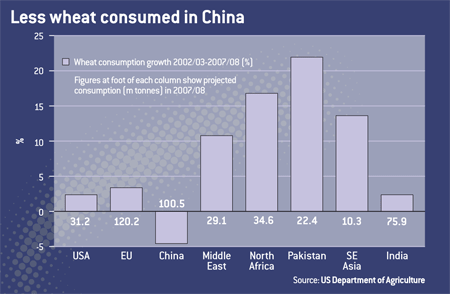Boom or bust – where now for cereal and oilseeds prices?

The surge in world market prices for cereals and oilseeds has been a boon to UK arable farmers. But for how long, asks Mark Berrisford-Smith
Tight supplies and dwindling stocks, coupled with rising demand in emerging economies and from a growing biofuels industry, are driving wheat prices higher and higher.
Or so it seems. After a grim decade for most farmers in the UK, it’s tempting to think that such agflation, as it is now being dubbed, is solidly underpinned.
But both the speed of the subsequent price rises and the sheer scale of the increase warrant detailed analysis for those who depend on this commodity market.
It is worth remembering that LIFFE wheat futures only broke through the £100/t level in April 2007. By the third week of January this year, they were trading close to the record highs of last September, when some farmers sold for about £180/t.

Last month, the HGCA predicted income of nearly £48,000 for a 100ha unit in 2007/08, based on an average ex-farm price of £162/t and on prevailing wheat futures. This is the best level for more than a decade.
The question that everyone is now asking is, will these high prices be sustained? Should growers be employing risk management strategies to lock in profits, or should they simply sit back and wait for £200/t or more?
Tight supplies
In any given year, the world produces and consumes a little over 600m tonnes of wheat. But since 2000/01, it has been the norm for wheat consumption to exceed the amount harvested.
In four of the past six years use has outstripped production, by 2.3% in the current year and as much 6.2% in 2002/03. This is unique between 1960 and 2000, there were only four instances of wheat consumption exceeding production in successive years.

The obvious consequence of this is shrinking stocks, a key factor behind the surge in prices. In January 2008, the US Department of Agriculture forecast wheat stocks at the end of this marketing year of 110.9m tonnes, compared with 124.4m tonnes at the start of the year.
That is just over half the peak level of the 1999/2000 season, and about 18% of expected use, the lowest since at least 1960.
The volume of wheat available to world markets is also important in setting prices. Total exports in the 2007/08 marketing year are expected to amount to 104.7m tonnes, about a tenth down on two years ago.
The price surge
Although the market has been tightening for several years, it was only in the 2006/07 season, when the stocks-to-use ratio fell to new lows, that prices started to respond.

But in view of the high wheat price and the temporary lifting of set-aside in the EU, it is hardly a surprise that the area seems to be increasing. At the moment, there is a reasonable chance that the coming harvest will set a new record.
The International Grains Council’s initial global forecast suggests an increase of 6.5% compared with 2007/08, at 642m tonnes. This would add upwards of 15m tonnes to global stocks, and bring the stocks-to-use ratio back up to about 20%.
Such prospects have had little impact on futures prices. Markets may not yet be convinced by the IGC’s predictions. But it does seem likely that the 2008/09 season should see a significant uplift to at least 620m tonnes.
Emerging economies
At a more fundamental level, it is argued that the supply position is likely to remain tight into the medium/long term because of the rising demand for foodstuffs and animal feeds in fast-growing emerging economies, and by the rapid growth in the use of biofuels.
The extraordinarily high rate of economic growth in China, India, and other emerging economies has had a marked impact on their patterns of food consumption. But while this has driven maize and soyabean prices, the impact on global demand for wheat has been minimal.

Even so, the Food and Agriculture Organisation estimates that the so-called Low-Income Food-Deficit Countries (LIFDCs) will need to spend 27% more on wheat imports in 2007/08, $31bn extra.
Maize use is also growing strongly because of the rapid expansion of the biofuels industry in the USA. The country accounts for more than 40% of world maize production and, this year alone, biofuels are expected to account for 83m tonnes, about a quarter of the US crop.
By contrast, production of biofuels in Europe has focused mostly on biodiesel, largely from rapeseed oil. The amount of wheat used for ethanol production was just 3.5m tonnes in 2006.
The industry seems set for rapid expansion, with the EU having set a target, not yet mandatory, that 5.75% of road transport fuels should be derived from biofuels by 2010, rising to 10% by 2020. But it remains far from clear whether biofuels produced from wheat will be an important element of this industry in the UK and Europe.
The big problem for biofuels is that the economics only stack up with subsidies, while the science is looking increasingly shaky. Given all these concerns, politicians suddenly are not quite as keen.
Focus is already shifting to so-called “second generation” technologies, which involve the processing of non-food grasses and bushes.
Key factors
The critical factor determining wheat prices for UK farmers will be the size of the next harvest, and whether it will boost the stocks-to-use ratio.
It is unlikely that a more comfortable market balance, with stocks at 20-25% of use, can be managed in a year. For this reason alone farmers can probably look forward to firm prices for at least the next two years.
But growers should remain wary about the impact of hedge funds and other investors in the wheat market. Once global economic growth and credit crunch issues are resolved, these investors could bail out.
That, together with improved harvests, could take much of the recent froth off prices. While a slide back to under £80/t seems unlikely, a retreat to less than £120/t, a level only passed last July, is by no means out of the question.
• Mark Berrisford-Smith is the senior economist at HSBC Bank.

